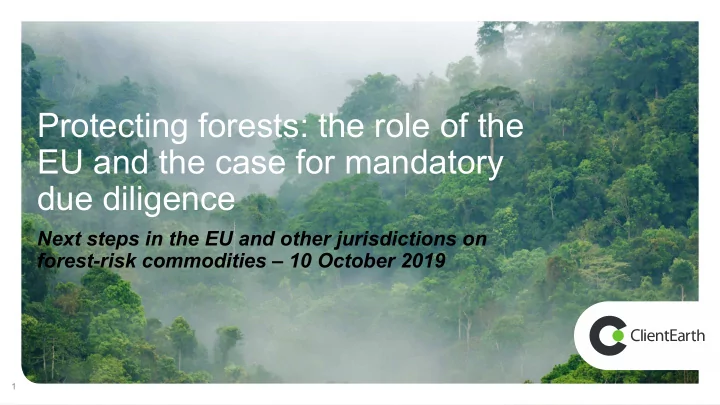

Protecting forests: the role of the EU and the case for mandatory due diligence Next steps in the EU and other jurisdictions on forest-risk commodities – 10 October 2019 1
EU context – long awaited Communication From 2008 to 2019 2014/2017 2013 Study EU 2019 2008 2018 Studies consumption Communication Communication Conferences 2
2019 Communication • Strong signal sent by the outgoing Commission to the next • Strongly supports the global approach, including a combination of supply side and demand side measures, in a partnership with producer and consumer countries, as well as with business and civil society: Strengthen the policy and regulatory framework Scale up efforts to support the rights of indigenous peoples and local communities Develop incentive mechanisms for smallholder farmers to encourage sustainable agriculture production EU trade agreements – encourage trade of agricultural products not causing deforestation Assessment of additional regulations to minimise the risk of deforestation and forest degradation from commodity imports into the EU pushing corporations to act responsibly 3
2019 Communication: what next? • EU failed to meet its own objectives to reduce gross tropical deforestation by 50% by 2020 • All indicators point to the emergency of protecting natural forests – immediate need to deliver the actions set out in the Communication • ClientEarth welcomes the EC Communication • Need from other EU institutions to support the Communication • More development needed for some of the EU priorities 4
Why do we need new regulatory measures? • Tree cover loss is rising • Guidelines and voluntary approaches are not enough • Interest of companies themselves – currently facing significant material risks: reputational, financial and legal • Help investors to fulfil their own commitments and obligations 5
What ClientEarth is suggesting: Mandatory due diligence • Based on our experience in the timber sector, and Global Witness’ experience in the extractive sector • Meaning of due diligence: ‘proactive and reactive process through which companies put in place systems and processes to make sure they are able to identify, manage and report on risks in their supply chain’ 6
Key steps of a due diligence process • Identify and assess risks and impacts : pinpoint potential or actual adverse impacts on people and the environment that could result from a company’s operations and its business relationships, within its supply chain • Take actions on risks and impacts identified – by preventing, mitigating and potentially ceasing • Monitoring and tracking responses • Stakeholder participation 7
Key questions for forthcoming legislation • Defining risks – the need for clear standards: human rights and environmental standards • Product scope: wide range of products • Scope of companies and the meaning of supply chain • Transparency and reporting: essential for implementation • Enforcement: penalty regime, enforcement authority, role of third parties like NGOs… 8
Thank you Clotilde Henriot Senior Law and Policy Advisor t +44 (0)20 30 30 5973 Chenriot@clientearth.org 9
Recommend
More recommend